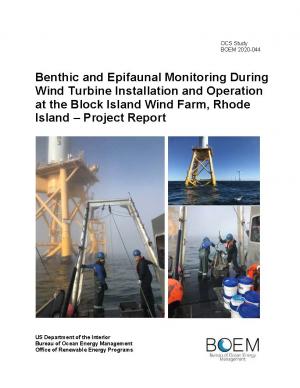Conducted by: HDR
Key Researchers: Zoë Hutchison, Monique LaFrance Bartley, Paul English, John King, Sean Grace, Boma Kresning, Christopher Baxter, Kristen Ampela, Mark Deakos, Anwar Khan
Funded by: BOEM
Benthic and epifouling monitoring was conducted within the BIWF Project area over four years (2016 to 2019) after turbine installation. Seafloor samples were collected at Turbines 1, 3, and 5 using a grab sampler deployed from a ship and analyzed for marine life, sediment type, and carbon content. Divers collected samples within the foundation structure during the last two years. Video transects of the legs were also conducted by divers. Additionally, a floating camera observed the seafloor near the platform legs.
Findings
Submerged sections of the BIWF jacket foundation structures were completely encrusted by mussels (Mytilus edulis) and associated species.
Significant modification of the seabed occurred within the footprint of the turbine foundations, with the area underneath Turbine 1 exhibiting the fastest rate of change.
An increase in abundance of black sea bass (Centropristis striata) around the foundations was observed between Years 2 and 3.
Benthic habitat four years after installation remain localized, with a profound change from a sandy habitat to a habitat characterized by mussel aggregations with associated organic matter, sediment fines and macrofaunal communities.
How BOEM will use this information
The results from this study are valuable in improving the understanding of changes to macrofaunal and sediment characteristics resulting from wind facility construction and initial operations in the New England region over short time scales.
The results and findings from this study could serve as the basis for extrapolation to larger wind facilities
and will provide useful information on the effects of jacket type foundations which are generally
underrepresented in European studies.
Additional information:
Final report: espis.boem.gov/final%20reports/BOEM_2020-044.pdf


